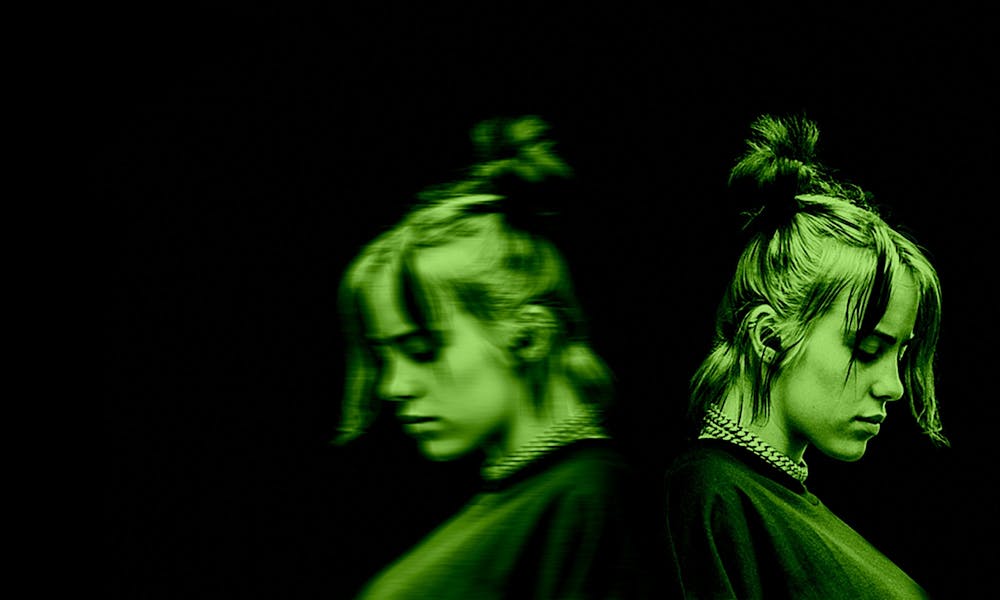Billie Eilish, only 19 years old, is the definition of a pop star. Her image is bold—oversized streetwear, jet–black hair with a splash of neon green—and her music is unique. Underneath the facade of her world–renowned name, chart–topping music, neo–goth image, and unambiguous talent, however, there breathes an emotional and fragile teenager with a story to tell. R.J. Cutler, in the two–and–a–half–hour Apple TV documentary Billie Eilish: The World’s a Little Blurry, pierces into the depths of Eilish’s mind, her family, and her reality—the good, the bad, and the ugly. The raw emotion painted throughout her narrative in this candid documentary intimately uncovers Eilish’s truth as a self–conscious and authentic artist confronting the pressures of worldwide fame.
The scenes from the film were mostly shot in 2019, a quintessential year in Billie’s transition from rising star to international sensation. Billie highlights the bare bones of her debut album, When We All Fall Asleep, Where Do We Go?, in scenes of uninhibited dialogue and close–ups on her relationships with her brother, parents, fans, and directors. The film masterfully reveals a battle between Billie’s health—her mental and physical deterioration— and the demand of having an acclaimed name and global musical influence.
Her vulnerability shines through in the film. In one scene, Billie flips through her confidential song notebook, exposing pencil drawings of her inner demons and pages of dark lyrics. During one of the most enlightening sequences of the film, Eilish talks candidly about her struggles with mental health in the past. She reveals that she had a history of cutting herself with razor blades, “making [herself] bleed because [she] thought [she] deserved it.”
Eilish fearlessly discusses her battle with Tourette syndrome, as well as the physical toll touring has taken on her body. We see her limping on and off stage after twisting her ankle performing, working to cope with her Tourette tics, and struggling to perform live day after day. The documentary both figuratively and literally brings us behind the stage of Billie’s life. If you saw Eilish's debut Coachella performance, it was an exciting and impressive showcase of her authentic image. However, the film exposes Eilish’s dismay at her performance after technical malfunctions, a delayed start, and her failure to remember the lyrics to her hit "all the good girls go to hell.” To top it off, Billie’s then–boyfriend, “Q,” failed to attend the show after she had begged him to be there. She throws her phone across the room in a moment of true teenagerish melodrama.
These instances of deadening stress and heartbreak unmask the facade of being a teenager in the spotlight, showing wounded skin underneath and endowing Eilish with an intimate validity.
However, Bille Eilish: The World’s a Little Blurry also substantiates the beautiful moments of Billie’s career and her close relationship with her brother and collaborator, Finneas O'Connell. The film ends at the Grammy Award ceremony, where Eilish wins five out of six categories she was nominated for. The reality of it all is that she still records her original music in Los Angeles in her parents' confined and cozy house. This modest humility is what makes Eilish’s fame so incredible: She is truly her own authentic self, and someone for teenagers around the world to relate to.
Billie’s own adolescence was pervaded by an obsessive idolization of Justin Bieber. At Coachella, Eilish meets Bieber for the first time and melts away due to her diffidence in his presence. She’s just like the rest of the Belieber fan club, despite having collaborated with Bieber on a remix of "bad guy."
The theme of family and loyalty seeps through the film and makes fans fall more in love with Eilish and her family. Specifically, Finneas helps write and produce Billie’s music, while simultaneously serving as an anchor for her spells of anxiety and stress. The documentary glimpses at their creative process; the two sit in the floor of her bedroom joking around, plucking strings of a guitar, hitting keys of a piano, and humming lyrics from her song journal until a track is developed. In the film, Finneas divulges that “Billie hates writing songs in general and is so woke about her own persona on the internet that I think she's terrified of anything that she makes being hated." Her insecurity regarding her own music is deep–rooted and manifests itself in her overall dark, aberrant sound.
Billie Eilish: The World’s A Little Blurry brings to light a new side of Billie Eilish that makes her unbelievably human, and reminds us she is a teenager. The film illuminates the moments that seem insignificant compared to her phenomenal rise to fame—getting her driver's license, feeling heartbroken on Valentine’s Day when “Q” failed to get her a gift, breaking down before a meet and greet. In actuality, these scenes piece together the Billie Eilish that is hidden behind her mysterious and dark facade. The vulnerability and rawness that comes through the screen explicate the harsh realities of battling mental health difficulties, fostering relationships, and growing up as a Gen Z in the world today.

